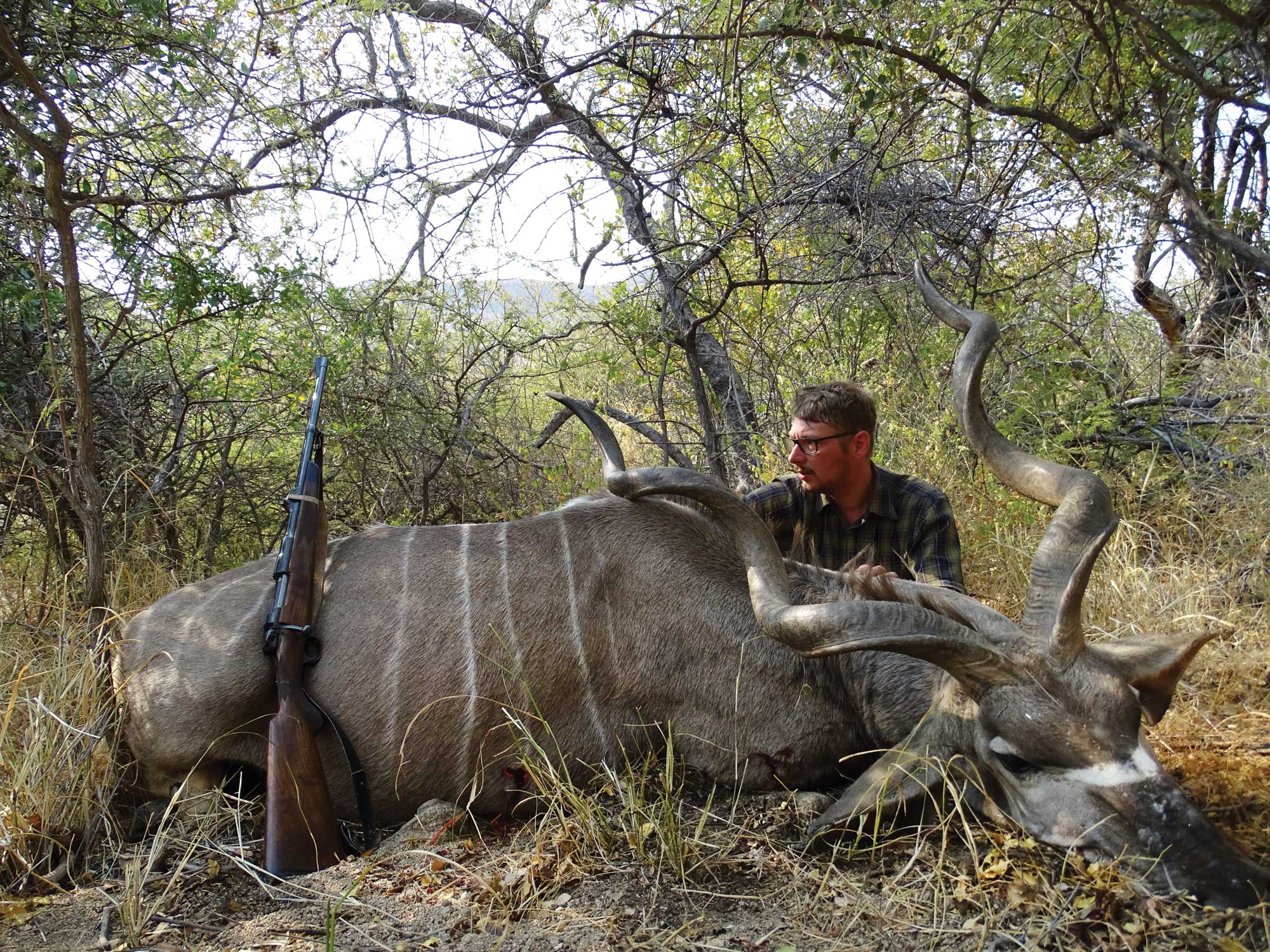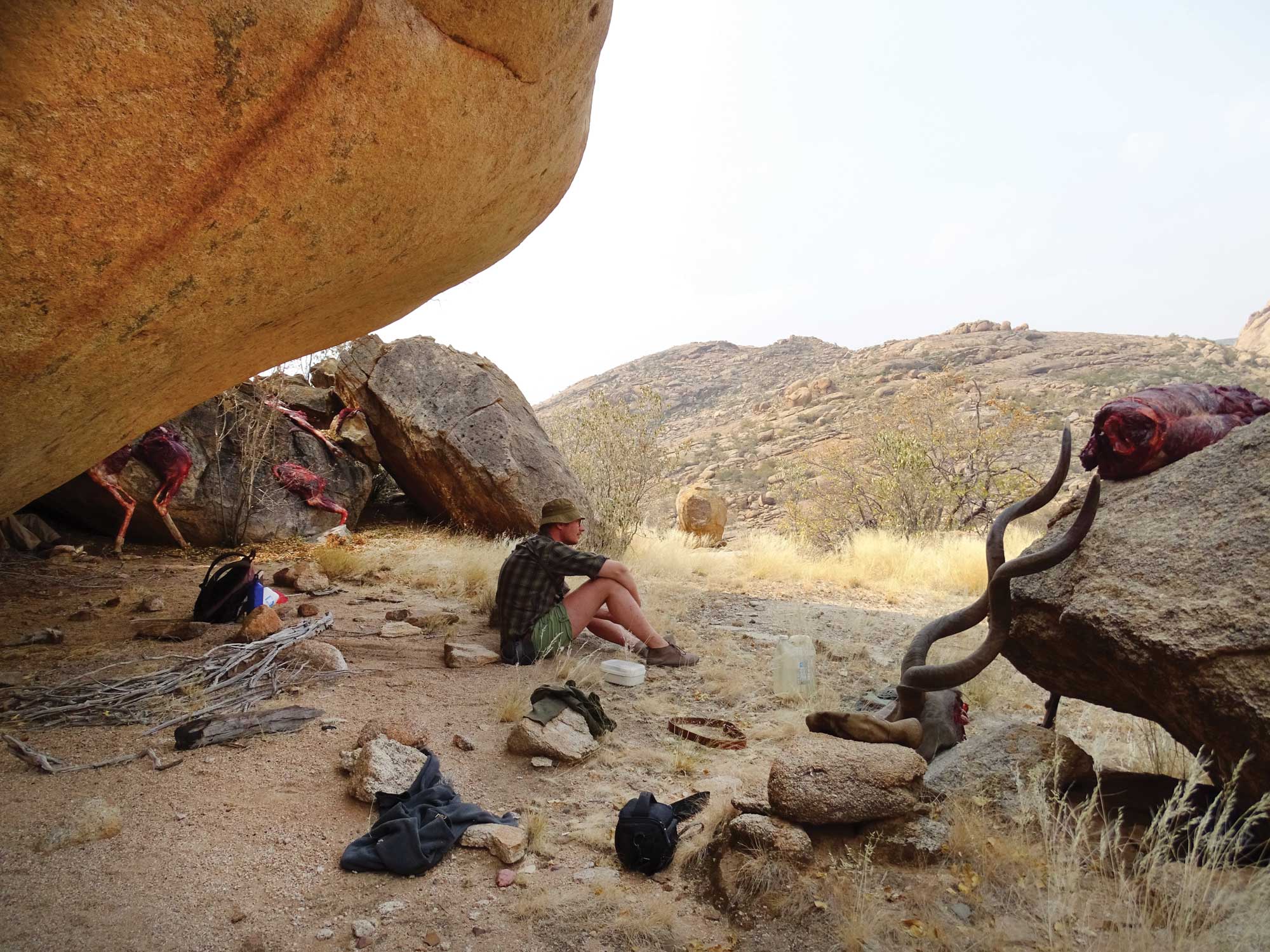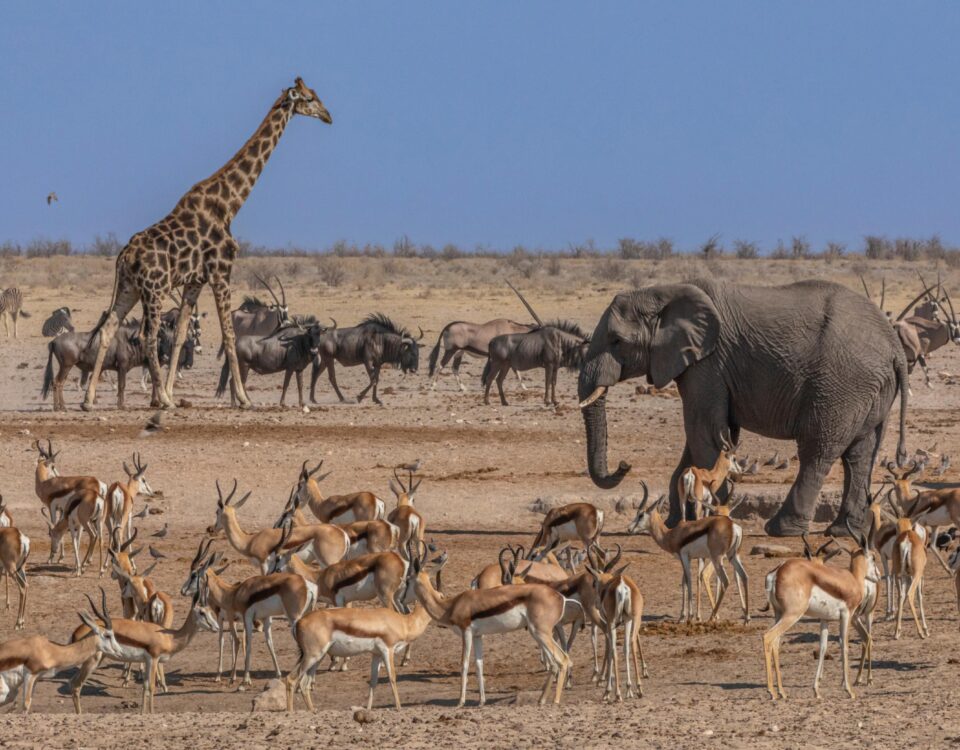
Collar me crazy
April 19, 2016
The vegan hunter
April 20, 2016T he farm was only 18 km away but Hagen reckoned that it would take an hour to get there. The track meandered through dry riverbeds and steep rugged mountains with enormous granite boulders looming large on both sides of the long valley. It was hard to imagine driving here with anything other than the indestructible Brit. Any European off-road fan would probably have broken out in cold sweat on this trip.
The farm couldn’t have been named more aptly than Schlucht. Though speaking of a farm may be slightly misleading, because this “south-western longitudinal valley of the Erongo Mountains” is neither used for agricultural purposes nor developed in any way. The farm is part of a large private nature reserve. When I noted that unexpected visitors probably don’t show up all that often, Hagen nodded in agreement and grinned.
After about 40 minutes Hagen stopped the car and we marvelled at rhino spoor across our path. I took a deep breath as I was suddenly filled with wonder by the realisation that I had arrived in a truly unspoilt mountain wilderness. The valley is partly covered with thick bush which thins out higher up, and right at the top is limited to ditches and small high-lying valleys. Towering Löwenkopf (2100 m) is the highest summit on the farm. I was not drawn to the Erongo for mountaineering as such, however, but in the hope of taking a really mature, old and shrewd kudu bull with hard work and fair chase. Finally I settled into my guest bungalow. There was no electricity and I didn’t need any.
After a brief siesta we climbed onto a small granite ledge a short distance away from the farmhouse.

Hagen negotiated the negligible difference in altitude without batting an eye while I followed sweating, my heart beating violently. “Phew”, I thought, “just a few little metres…” and looked slightly worried at the mountains around us. Instead of jogging, to get fit for the hunt, I should rather have exercised by running up the stairs in a building with several floors. Well, there was nothing to do about it now. It took a few minutes before my hand was steady enough to hold the binoculars for scanning the slope on the opposite side. After a while Hagen pointed to a small herd of black-faced impala, so beautifully proportioned. They were happily grazing on a small open space below us, perhaps some 400 m away. When the sun started to dip towards the mountainous horizon we decided to call it quits.
The next morning I got up at 05:30, it was still dark outside. Just a quick lick and a promise and I was ready for coffee and biscuits on the veranda. At the first sign of dawn we were already rumbling west. We intended to leave the Landy in a side valley and from there climb onto a granite hill which changes into a plateau. We wanted to look for a kudu on the plateau’s steep edges. The ascent was exhausting and I tried to slow down to keep my breath. Later, Hagen said that going slowly on the way up was invented by hunters in the Alps who have the whole day at their disposal. Here, on the other hand, one has to move at a pace in order to gain time for scanning the area from the top. “Because as the sun rises and it becomes warmer kudu take shelter in the shade and stop moving”, Hagen explained. Right, makes perfect sense.
I was busy picking my way around a thorn bush which tried to entangle me when a snort and the sound of loose stones rolling downhill made me look up. Unwittingly we had come too close for comfort to a zebra stallion. He literally flew up the mountain, then paused on a slab of granite and looked back. After a brief moment he had sized up the disturbance and continued with incredible ease on his way up across the slab, which was about 100 metres long. Next he was gone and I was mightily impressed.
We spent the whole morning scanning the plain and the slope on the opposite side with our binoculars. We spotted Oryx, zebra, klipspringer… until at some stage Hagen said “kudu bull”!
Despite Hagen’s directions it took a long time before I finally saw him, too. He looked so small that I wondered how Hagen managed to detect him in the first place. At a distance huge rocks look like mere stones and you tend to expect equally large animals. Mother Nature provides the kudu with excellent camouflage. Add to that his quiet composure and he is extremely difficult to spot. If you don’t memorise the exact location you will often be unable to catch another glimpse of him, which makes stalking him rather hopeless. But in this case Hagen determined that the bull was not old enough. Since no other animals made an appearance and the sun had risen quite high in the sky, we decided to leave the mountain.
In the evening we climbed up a slope east of the farm and spotted more kudus, but there was only a young bull among the ladies. Back at the farm I took a hot shower and after a delicious dinner fell into bed tired and exhausted to sink into a deep, dreamless sleep.
The following days took a similar course. We inspected various slopes and valleys without spotting a mature kudu. Gradually I managed the climbs with less pausing. Amazing, how quickly the body can adjust to conditions requiring fitness. And my eyes, used to ‘East Frisian Green’, adapted to ‘Erongo Grey’.
On the afternoon of the fourth day we climbed onto a long mountain crest directly behind the farmhouse. From that bare granite mountain we wanted to look into a valley, scattered with islands of bush like a mosaic. In a small dry riverbed we found the track of a big leopard whom we already had heard quite often in the mornings or evenings when we were sitting on the veranda. I had no way of knowing that this leopard had an extraordinary experience in store for me. The view from the top of the mountain was truly fantastic. We were looking down into a valley lined by enormous rocks as high as a house. Huge granite slabs in the middle were baking in the sun. We carefully scanned the valley, but when we couldn’t spot a kudu we decided to stalk a small group of highly alert klipspringers. After all, there might just be an old male among them.
While the San tracker in our company remained at the lookout spot, Hagen and I took a detour. Using every little bit of cover we first slid down a slab of rock and later crawled on all fours (more in the manner of crabs) through one of the islands of bush. Right in the middle of the dense bush I heard light sounds, like a hare bolting. I didn’t see one, it just sounded like one. A few metres on, Hagen asked whether I heard the kudus. “I think I heard a hare”, I replied, only to learn that kudus manage to slip away in a surprisingly quiet manner.
Ok then, back to crawling towards the klipspringers. Soon we were close enough for Hagen to identify a mature and suitable male. I edged a little forward, but the buck noticed the movement and jumped away of course. Nevertheless I kept aiming at him and when he turned around and looked back I let go and took a very good trophy of an old klipspringer in a truly grand natural setting.
Dusk was setting in and while I was busy gutting the buck, the San tracker told us that he saw three kudus emerging from the island of bush which we crossed, one of them a big one. More’s the pity, but I was quite happy as it was. I quickly turned the rumen inside out, gave the entrails to the tracker, handed the rifle to Hagen and shouldered the small antelope.
As we turned around a bend we heard some rumbling and saw an impressive kudu crossing the granite slab and pausing at a distance of 80 metres. Without thinking twice and full of excitement I grabbed my weapon but Hagen brought me back to reality. “Quite a handsome kudu”, he said, “but he is not old enough”. Well, it would have been too good to be true…. We walked the rest of the way in complete darkness.
During the following days we concentrated our search on the area of the plateau which we had visited at the start of the hunt. We sat behind some rocks and I watched a solitary Oryx cross the plain down below. “There must be a mature kudu somewhere in this remote corner”, Hagen reckoned. The whole morning a troop of baboons had been kicking up a racket at some distance, and now, as if to spite the hunters, a kudu suddenly added his voice. Immediately we trained our binoculars to the direction from which we heard the deep sound… but we couldn’t see him. Towards evening we moved closer to where we thought he was but our efforts were fruitless. The kudu remained invisible – a characteristic of this attractive animal.
For the next day, my birthday, I asked Hagen to have a cushy number and just look around the main valley for a black-faced impala.
The early morning stalk led to nothing. That afternoon Hagen’s sister Ilka dished up a yummy chocolate cake and after tea we were on our way again. During an exciting stalk I got the chance to shoot a big impala buck.
However, I was shooting freehand and immediately became aware that the weapon dropped. Probably the shot went off too low.
The buck was wounded and I was very cross with myself as we started the search for the tormented creature. The San tracker followed the spoor with incredible certainty while Hagen and I kept on either side to increase the visual angle and field of fire.
After quite a while we had come close to the buck. In the dense bush we couldn’t see him but we heard something. All of a sudden there was loud growling and the sound of branches snapping. We stopped dead in our tracks. Then, inching around a thick bush we saw a leopard disappear. The wounded buck had happened into its path and the big cat had brought him down and locked its jaws into his throat. When we turned up the leopard bolted – such an annoying interruption for the cat…

I, on the other hand, was glad that we had found my buck and I finished him off with the knife. What an experience to have on my birthday, with assistance rendered by a leopard, a beautiful strong cat from which we snatched back our prey and his dinner.
On the second last day of the hunt we decided to go to the Löwenkopf, the highest peak in the hunting area, for the whole day. Breakfast was already at 5 o’clock. It was a really chilly morning and I quickly changed the shorts for pants and grabbed a jacket before we were off in the dark, driving east.
As dawn was breaking about half an hour later we arrived at the Löwenkopf, much to my surprise right in front of it. Three San hunters were accompanying us. Should we be successful that day, they would help us to recover the animal from what must be the remotest corner of the hunting area. After getting rid of the warm clothes and putting on backpacks with provisions for the day we were ready to tackle the rather steep ascent.
I soon realized that we didn’t stop directly in front of the Löwenkopf at all. As the early morning got brighter I could see that it was still a considerable distance over endless granite slabs and rocks. As it turned out it was the longest and most exhausting climb of the whole trip. After several breaks we finally arrived at the edge of a valley. Hagen suddenly ducked down and looked for cover. Through his binoculars he gazed at three kudu bulls which seemed to have heard something and were already on the move. There was no point in me trying to spot them at this stage because I was unable to hold my binoculars steady. Hagen told me that one of the bulls was an impressive one. We sneaked forward to an open spot a few metres away from which we scanned the slopes again.
Since we couldn’t find the bulls, Hagen and I climbed to a slightly higher valley in the direction where we imagined them to be and continued scanning. After a few minutes I spotted one of the bulls and pointed out his location to Hagen. The bull stood between two large bushes some 400 metres away from us. “Rather long horns”, I whispered. Then Hagen saw him, too. “That’s the right one!” he said after a brief assessment.
There was no time to waste. We decided that Hagen would go and fetch the San hunters while I kept my eyes on the kudu bull. Hagen was back fifteen minutes later. The kudu had moved on but didn’t seem to be in a hurry. We set off on a rather wide detour to get to a small ravine. The kudu was at the end of the ravine, we figured. We were walking for a good half hour and arrived at a spot where the San hunters remained behind while only Hagen and I continued on our way up for a better view of the ravine. “Now the challenge is on”, Hagen reminded me urgently. “If he sees or hears us he’ll be gone”.
We edged forward to the rim of the ravine as quietly as possible. From behind a head-high boulder we were scanning for the kudu again. I am still quite proud of myself that I actually found him. There he was, standing under a large projecting rock, some 200 metres away. Hagen made sure that it was indeed the right one and then the thrill of the chase got hold of us. But for a good shot we still had to shorten the distance. Regardless of thorns or sharp stones on the ground we quietly moved closer to the much yearned-for antelope that we had been searching for so intensively.
After climbing through the last obstacle, a narrow hole in the rock, we stood hunched over a granite boulder and I directly came to the ready. Taking aim I lost sight of the kudu but Hagen got me back on track. There he was, well-camouflaged, secretive, a grey ghost. Another deep breath and the shot went off. Since the kudu didn’t take flight but slowly moved around a yellow shrub I pulled the trigger again. Still nothing, he was heading into the bush.
I needed to sit down. While I lit a cigarette with trembling fingers Hagen reassured me: “I saw that the first shot was a good one.” So, nothing to keep us up there. I immediately stubbed out my cigarette. Keeping our ears pricked and our eyes peeled we carefully made our way around the thicket. There was no sound, just complete silence. Halfway around the patch of bush we found the spoor and less than 30 metres on, the dead kudu. My kudu.
I was overwhelmed by the sheer size of this animal. Full of wonder I looked at the very old bull and his strong neck and long, even horns. The left one is a little battle-worn, the ears are frayed. A truly magnificent animal. A great hunt. I felt a sense of deep satisfaction seeping through me.
But after a gripping hunt and taking a magnificent animal doubts always tend to crop up. When the San tracker who accompanied us during this hunt joined us a little later at the kudu’s side and with his calm, almost soft voice said “groet die dier!” I could only agree.
This article was first published in the HUNTiNAMIBIA 2016 English edition.


